An instant hot water dispenser is a modern kitchen appliance that provides hot water on demand, dispensing it directly from a tap.
The advantage of such a device is its ability to quickly supply water at a near-boiling temperature, eliminating the wait time associated with traditional methods like boiling water on a stove or waiting for an electric kettle.
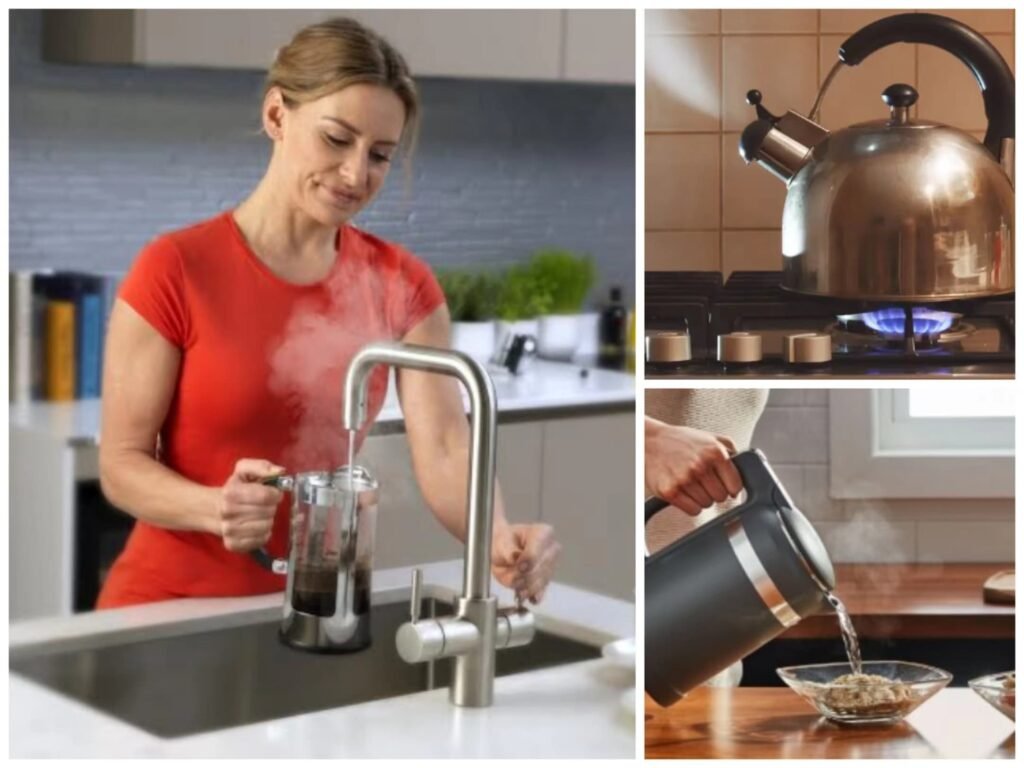
This convenience makes it a useful addition to both home and office kitchens, where speed and efficiency are often valued.
The mechanism behind an instant hot water dispenser involves heating water to a high temperature and maintaining it within a tank, so it is ready to use at a moment’s notice.
When the user activates the dispenser, hot water travels from the tank through the faucet, providing an immediate and continuous flow.
Users can adjust the water temperature according to their needs, whether for making hot beverages, preparing instant foods, or performing other tasks like warming bottles or cleaning.
Furthermore, installing an instant hot water dispenser can lead to energy savings compared to repeatedly heating water for various kitchen tasks.
It is designed to be energy-efficient, maintaining water at the desired temperature without the need for constant reheating.
This appliance blends seamlessly into modern kitchen designs, often coming with a range of customizable options to match different styles and user preferences.
Understanding Instant Hot Water Dispensers
Instant hot water dispensers are systems that provide near-boiling water on demand, streamlining tasks that require hot water, such as making tea or cooking. They are valued for their speed and convenience.
Components and Functionality
An instant hot water dispenser typically consists of the following key components:
- Heating Element: Heats the water to the desired temperature quickly.
- Tank: Stores water and keeps it hot until needed.
- Thermostat: Monitors and regulates the temperature of the water within the tank.
- Faucet: Dispenses the hot water when activated, usually mounted on the sink.
- Water Inlet: Connects to the water supply to fill the tank.
- Filter: UF or RO are both workable to connect with the water boiler to supply clean water for drink.
The dispenser heats water within a small tank and maintains it at a near-boiling temperature.
When the faucet is activated, hot water is instantly delivered, while cold water flows into the tank to be heated for future use.
Benefits of Using an Instant Hot Water Dispenser
The benefits are varied and include:
- Efficiency: Provides hot water without the wait, saving time in the kitchen.
- Energy Saving: More energy-efficient than boiling a kettle for small amounts of water.
- Convenience: Offers immediate access to hot water, simplifying many cooking and cleaning tasks.
- Safety: Reduces the risk of accidents associated with handling boiling water on the stove.
Users appreciate instant hot water dispensers for their ability to transform routine kitchen activities by delivering hot water at the moment it’s needed. Their efficiency and convenience are significant advantages for any home or office setting.
Types of Instant Hot Water Dispensers
Instant hot water dispensers are systems designed for quick and convenient access to boiling water. They vary by design, capacity, and the method of heating water.
Tank Models
Tank models feature a small insulated tank that stores and heats water to near-boiling temperatures, making them a hot-only system.
They are often installed beneath a sink and connected to a separate, dedicated faucet on the counter.
The capacity of the tank typically ranges from one-third to over half a gallon, allowing a steady supply of hot water on demand.
Tankless Models
Tankless models, also known as on-demand hot water dispensers, heat water directly as it flows through the unit without the need for a storage tank.
These systems are valued for their energy efficiency and continuous supply of hot water.
They come in various sizes to accommodate different flow rates and are usually more compact than tank models.
Faucet-Integrated Models
Faucet-integrated models combine the hot water dispenser system with a regular kitchen faucet.
This faucet style allows users to switch between regular tap and hot water without needing a dedicated hot water faucet.
These models are well-suited for those who prefer a streamlined kitchen design and are looking to save space.
Installation and Maintenance
Installing an instant hot water dispenser involves specific plumbing requirements, while maintenance is key to ensure its longevity and optimal performance.
Installation Process
The installation of an instant hot water dispenser requires a step-by-step approach.
Firstly, one should confirm compatibility with existing plumbing. Most dispensers need a connection to the cold water supply line and an available power outlet.
Ensure that the area under the sink is clear to accommodate the dispenser’s tank.
Steps for Installation:
- Shut off the cold water valve.
- Install the saddle valve or tee off the cold water line.
- Connect the dispenser’s tank to the water line and to an electrical outlet.
- Mount the spout in the sink hole, often where a soap dispenser or sprayer would go.
- Open the water valve and check for leaks.
- Follow specific manufacturer instructions for any additional steps.
Routine Maintenance
Maintenance ensures the dispenser functions properly and provides clean water.
Filters play a crucial role and should be replaced as recommended, typically every 6 to 12 months.
Maintenance Checklist:
- Inspect the equipment regularly for wear and leakages.
- Clean the dispenser’s spout and tap to prevent mineral build-up.
- Replace the water filtration system cartridge or filter when necessary to maintain water quality.
- For longevity, descaling the heating tank periodically may be required depending on water hardness.
Each step of the installation and maintenance process should adhere to the manufacturer’s guidelines for safety and warranty purposes.
Design and Styles
Instant hot water dispensers offer a combination of functional design and aesthetics to fit various kitchen styles and preferences.
Manufacturers are attentive to both the unit’s form and its finish, ensuring customers can find the appropriate complement for their decor.
Choosing the Right Finish
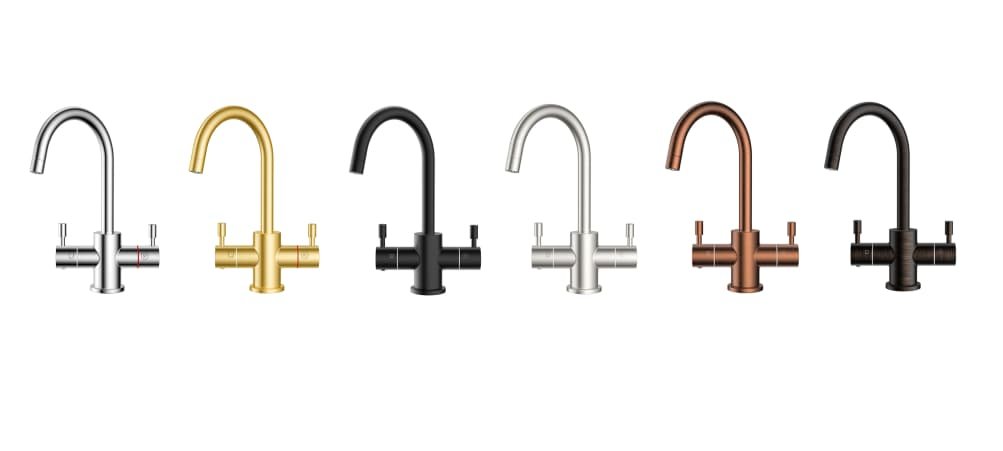
When selecting an instant hot water dispenser, it is crucial to consider the available finishes, which include but are not limited to:
- Stainless Steel: A popular choice for its durability and ease of matching with modern appliances.
- Chrome: Offers a high-gloss finish that pairs well with contemporary and transitional kitchen styles.
- Bronze: Ideal for traditional kitchens, adding a warm, classic look.
- Matte Black: A finish that has gained popularity for its sleek and bold appearance, suitable for various decor themes.
Manufacturers typically ensure their dispensers’ finishes are resistant to fingerprints and water spots, maintaining their aesthetic appeal over time.
Matching Decor and Style
The style of an instant hot water dispenser should harmonize with the kitchen’s existing fixtures and decor. Here are key considerations:
- Faucet Design: Dispensers typically come in a range of faucet designs, from vintage-inspired to streamlined modern shapes.
- Visual Cohesion: To achieve a cohesive look, the dispenser should complement the shapes and lines of the kitchen’s existing faucets and handles.
- Consistency: Homeowners should seek a balance between the dispenser’s style and the overall kitchen theme, ensuring that it doesn’t stand out awkwardly.
By carefully assessing both the finish and style, one can ensure that the instant hot water dispenser enhances the kitchen’s aesthetics while also providing the convenience of immediate boiling water.
Practical Uses in the Kitchen
An instant hot water dispenser offers efficiency and ease for various kitchen tasks. It provides near-boiling water on demand, which is a significant asset for both cooking and beverage preparation.
Cooking and Food Preparation
- Boiling: An instant hot water dispenser expedites the boiling process for pasta or vegetables by providing hot water instantly. This reduces waiting time for water to boil on a stove.
- Thawing Frozen Food: It aids in quickly thawing frozen foods by providing a steady stream of hot water, which is more efficient than waiting for cold water to do the job.
- Cleaning Dishes: Stubborn food residue on dishes can be removed with ease using the hot water from the dispenser, making the cleaning process quicker and more effective.
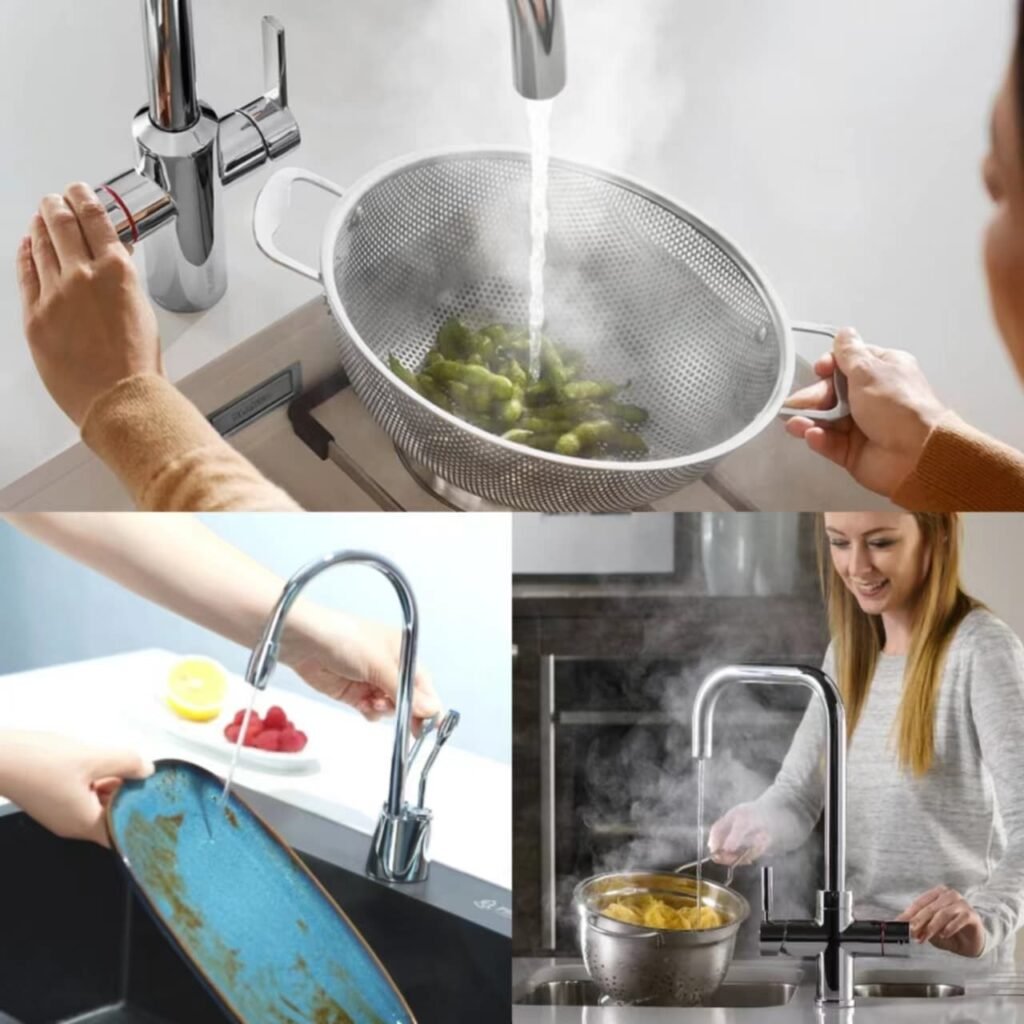
Hot Beverages and Convenience
- Coffee/Tea Making: The dispenser ensures that hot water is always at the ready for tea, coffee, or other hot beverages, streamlining the preparation process.
- Convenience: Whether it’s preparing hot cocoa or a warm cup of lemon water, the on-demand hot water availability enhances the convenience in the kitchen, eliminating the wait associated with a traditional kettle or pot.
Safety Features
Instant hot water dispensers are designed with a number of safety features to ensure the user’s protection. These features primarily focus on regulating water temperature and preventing accidents during operation.
Temperature Control
- Thermostat Adjustments: Modern dispensers are equipped with adjustable thermostats, allowing users to select a specific water temperature.
- Auto Shutoff: Should the temperature exceed a safe level, an automatic shutoff mechanism engages to prevent overheating and potential burns.
Avoiding Accidents
- Child-Lock Mechanisms: To prevent unintentional dispensing, especially by children, these devices often include a child-lock feature.
- Insulation: Proper insulation around the water tank and dispensing area minimizes the risk of burns by keeping the exterior cool to the touch.
Product Selection and Pricing
When selecting an instant hot water dispenser, consumers must consider the different brands available and the associated price points. Features and quality can vary significantly, influencing both performance and cost.
Comparing Different Brands
The market is replete with a diversity of brands, each presenting a range of products distinct to their identity. InSinkErator, a distinguished name in the industry, offers two notable models – the Hot250 and the Hot150. These models are distinguished by their varying capacities and feature sets.
The Hot250 is known for its high-capacity tank suitable for busy kitchens or small offices, while the Hot150 caters to domestic needs with a more compact design.
Consumers should compare:
- Capacity: Hot250 has a larger tank.
- Features: Both may have different temperature settings.
- Reputation: Look at customer reviews and ratings.
| Brand | Model | Capacity | Features |
| insinkerator | Hot250 | Larger | Multiple temperature settings, quicker heating time |
| insinkerator | Hot150 | Smaller | Basic settings, designed for home use |
Understanding Price Points

Pricing for instant hot water dispensers like the Hot250 and Hot150 starts at different levels, influenced by their specifications and capabilities.
The Hot250 is typically more expensive due to its superior functionality, designed for more frequent use.
Consumers will find the Hot150 at a lower price point, reflecting its more basic feature set and lower capacity.
Key considerations include:
- Budget: Higher prices for more features and capacity.
- Value: Evaluate cost versus benefits for each model.
Examples of price points might be:
- Hot250: Ranges from $300 to $450.
- Hot150: Ranges from $150 to $250.
Energy Efficiency and Sustainability
Instant hot water dispensers can contribute to a more sustainable and energy-efficient home by minimizing the energy usually required for water heating.
Reducing Energy Consumption
These systems typically use less energy compared to traditional water heaters.
Standby energy loss is greatly reduced, as they heat water on demand rather than maintaining a full tank at a constant high temperature.
In practice, this means when a user activates the dispenser, only the necessary amount of water is heated, resulting in substantial energy savings.
- Power usage: On average, dispensers use energy only when engaged.
- Efficiency: They are typically designed to be highly efficient, with some models utilizing advanced technologies to minimize heat loss.
Eco-friendly Options
Manufacturers are increasingly producing eco-friendly models of instant hot water dispensers.
Features such as low-power modes and programmable settings let users have further control over energy use.
Recyclable materials and long-lasting designs reduce environmental impact from production and disposal.
- Sustainable materials: Options include units made with less plastic and more recyclable metals.
- Longevity: Durable components lead to fewer replacements and reduced waste.
Advanced Features and Innovations
In the evolution of instant hot water dispensers, advanced features and technological integrations set modern units apart from their predecessors. These innovations enhance both functionality and user experience, aligning with the expectations of contemporary lifestyles.
Smart Technology Integration
The inclusion of smart technology has revolutionized instant hot water dispensers.
Users can now control their dispensers via mobile applications or voice commands, adjusting temperature or setting schedules with ease.
They often come with touch screens and connectivity to home automation systems, allowing for remote monitoring and control.
- Remote Control via App
- Adjust temperature
- Set dispensing schedules
- Voice Command Compatibility
- Touch Screen Interfaces
- Home Automation System Connectivity
Futuristic Designs
Manufacturers are adopting futuristic designs that are not only aesthetically pleasing but also multifunctional.
These dispensers are often compact and can be a seamless addition to any kitchen décor.
Integrated LED indicators and touchless operation—utilizing a wave of the hand—underscore the dispenser’s commitment to hygiene and modern convenience.
- Aesthetically Pleasing and Compact
- Multi-functionality
- Integrated LED Indicators
- Touchless Operation
- Wave of the hand technology
Brand and Product Reviews
In this section, insightful data from customers and authoritative sources regarding instant hot water dispensers are gathered. The analysis of feedback from various platforms ensures well-rounded reviews.
Consumer Ratings and Feedback
Consumers often turn to retail giants like Amazon and Home Depot to express their opinions on instant hot water dispensers.
Ratings and written feedback on these sites can be instrumental in determining product satisfaction.
Brands like Insinkerator often receive numerous reviews, providing prospective buyers with a broad sense of product reliability and performance.
- Amazon:
- Insinkerator HWT-F1000S:
- Rating: 4.3/5 stars
- Highlights: Praised for ease of installation and prompt hot water delivery.
- Concerns: Some reports of durability issues over extended use.
- Insinkerator HWT-F1000S:
- Home Depot:
- Insinkerator Invite H-HOT100:
- Rating: 4.5/5 stars
- Highlights: Users commend the unit for its quick heating capability and compact design.
- Concerns: A minority of reviewers mention challenges with the adjustment of temperature settings.
- Insinkerator Invite H-HOT100:
- Note: The above data represent a snapshot of the ratings and are subject to change over time.
Expert Opinion and Endorsements
Respected review websites such as Reviewed play a crucial role in providing expert, detailed assessments of instant hot water dispensers.
Their evaluations often factor in the design, performance, value for money, and technological advancements of various brands and models.- Reviewed.com:
- Insinkerator HWT-F1000S:
- Verdict: Highly recommended for its energy efficiency and consistent performance.
- Expertise: Evaluations based on thorough testing and side-by-side comparisons with competitors.
- Insinkerator HWT-F1000S:
- Reviewed.com:
Accessories and Extras
To enhance the functionality and performance of instant hot water dispensers, various accessories and extras are available. They help maintain the quality of the output and adapt the system to fit different installation criteria.
Additional Filters and Cartridges
For those seeking to ensure a consistent supply of filtered drinking water, adding additional filters or replacing cartridges is crucial.
Filters vary depending on the desired level of purification:
- Sediment filters remove particulates.
- Carbon filters improve taste and odor.
Replacing cartridges regularly maintains water quality and prevents clogs.
| Filter Type | Purpose | Replacement Frequency |
| Sediment filters | Remove particulates | 6–12 months |
| Carbon filters | Improve taste and odor | 3–6 months |
Faucet Extensions and Adapters
To customize the spout reach or to accommodate non-standard sinks, faucet extensions and adapters are beneficial.
These parts come in different sizes and finishes to match the dispenser’s look:
- Spout extensions increase the reach.
- Adapters help the faucet fit unique sink setups.
- They are typically easy to install and can significantly enhance the user experience.
| Accessory | Function | Compatibility |
| Spout extensions | Increase spout reach | Specific to brand/model |
| Adapters | Adapt to unique sink setups | Universal/Brand-specific |
Troubleshooting and Repairs
An instant hot water dispenser requires regular maintenance to function correctly. When problems arise, identifying common issues is the first step, followed by deciding whether a DIY fix is sufficient or professional help is needed.
| Quooker | Grohe | ISE | ZIP | Billi |
| Netherland | Germany | USA | Australia | Australia |
 |
 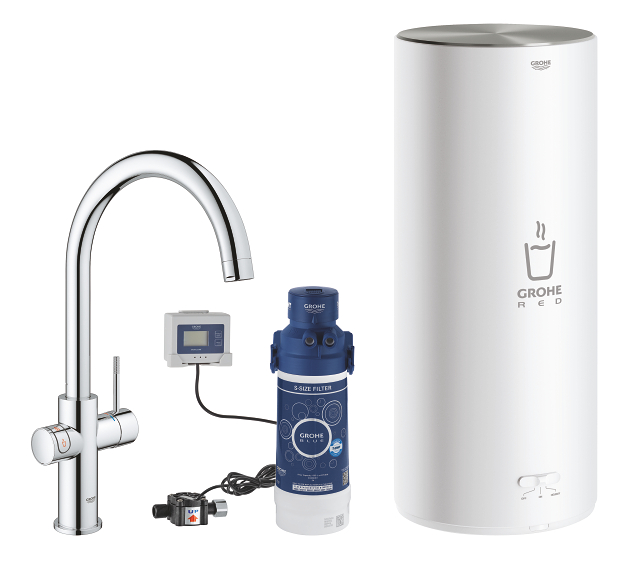 |
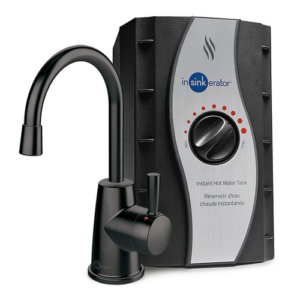 |
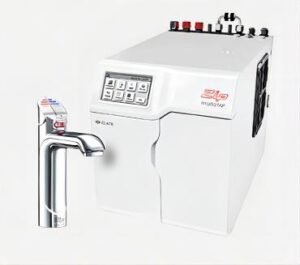 |
 |
| C or U,L spout; various finishes | L, C or U spout; multiple finishes | J, U or L spout; multiple finishes | C or U spout,various finishes | J spout and electronic touch panel , multiple finishes |
| £1545- £2945 | £1248-£1859 | $459-$1729 | $5159-$6485 | $1984-$6579 |
| Cold, hot and boiling, chilled sparkling water | chilled,medium and sparkling | hot,cold ,boiling ,chilled water | Boiling, Chilled & Sparkling Filtered water, plus Hot and Cold | boiling ,still,chilled,sparkling |
| 3L,7L,15L | 3L ,5.5L | 2.5 L | residential commercial | home work |
| PRO3:15*15*47 PRO7:50*50*20COMBI:50*50*20CUBE:440*235*405 | 3L: Φ21*37 5.5L: Φ21*49cooler: 23-5/8 in. W x 19-11/16 in. D x 16-15/16 in. H | soda chiller280mm x 406mm x 333mm all in one 339mm x 462mm x 333mm | C&S 410mm h x 255mm w x 420mm d Boiling 340mm h x 180mm w x 365mm d | |
| 2.4L/min ffiltered chilled water 2L/min filtered sparkling water | 3.2 gal/hr chilled water | 60 cups of water per hour | Commercial: Boiling Cups per hour:100Chilled Cups per hour:75 | Boiling Cups per hour:60 Chilled Cups per hour:60 |
| wifi | Bluetooth, wifi |
Common Issues
- No Hot Water:
- Check the power source and ensure the unit is plugged in.
- Reset the unit if it has a reset button.
- Examine for any tripped circuit breakers or blown fuses.
- Water is Too Hot or Not Hot Enough:
- Adjust the thermostat settings accordingly.
- Verify the proper functioning of the thermostat.
- Leaks:
- Tighten any loose connections.
- Replace worn out or damaged seals.
- Strange Taste or Odor in Water:
- Replace the filter, if applicable.
- Descale the unit to remove mineral buildup.
- Noise During Operation:
- Inspect for any loose components and tighten them.
- Descale to eliminate possible noise from mineral buildup.
DIY Fix or Professional Help
- Simple Tasks (e.g., resetting the unit, adjusting the thermostat, tightening connections, and replacing filters):
- These can typically be done by the user with basic tools and by following the manufacturer’s instructions.
- Complex Issues (e.g., internal component failure, tank leaks, electrical faults):
- It is recommended to seek professional assistance to avoid further damage to the unit or personal injury.
Where to Buy
Instant hot water dispensers can be purchased through a variety of online and local retail channels. Consumers can compare inventory levels, prices, and place orders at their convenience.
Online Retailers
Inventory Levels: Online retailers often have a vast selection of instant hot water dispensers with real-time inventory updates. Customers can view availability and product specifications on these platforms.
Amazon, eBay, and Wayfair are primary examples of online retailers where customers can purchase instant hot water dispensers. These sites typically offer:
- A wide range of models
- Competitive pricing
- Detailed product information and reviews
- Option to place orders 24/7
Local Suppliers and Stores
Local Store Prices: Prices at local suppliers might vary compared to online options, but they offer the advantage of seeing the product before purchasing.
Sales personnel can assist with questions regarding the different models.
Local home improvement stores like Home Depot and Lowe’s stock instant hot water dispensers. They also offer:
- Immediate purchase without the wait for shipping
- Personalized customer service
- In-store promotions and deals
Legal and Warranty Information
When purchasing an instant hot water dispenser, consumers should be attentive to the warranty coverage and the terms of service, which govern usage and customer support.
Understanding Warranty
Warranty Duration: Most instant hot water dispensers come with a warranty period that typically ranges from one to three years from the date of purchase.
- Coverage Specifics:
- Manufacturing Defects: The warranty usually covers defects in materials and workmanship.
- Parts and Labor: It often includes parts and labor for repairs.
- Exclusions: The warranty may not cover damage due to improper installation, accidents, misuse, or normal wear and tear.
Transferability: Warranties may be non-transferable; the original purchaser is usually the sole beneficiary of the warranty service.
Terms of Service
Acceptance of Terms: By purchasing and using an instant hot water dispenser, the consumer is typically agreeing to the manufacturer’s terms of service.
- Proper Usage:
- Instructions for proper use should be followed as outlined in the user manual to ensure the validity of the warranty.
- Customer Support:
- Contact Information: Manufacturers provide customer support through various channels, including phone, email, or live chat.
- Hours of Operation: Support hours are commonly mentioned in the terms, indicating when consumers can seek assistance.
Changes to Terms: Manufacturers reserve the right to amend terms of service at their discretion, with changes often communicated through their official website.
